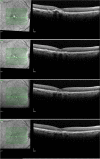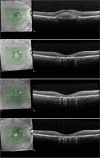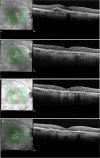Geographic Atrophy after Reabsorption of Pigment Epithelial Detachment (GARPED) study
- PMID: 37254103
- PMCID: PMC10228064
- DOI: 10.1186/s12886-023-02993-3
Geographic Atrophy after Reabsorption of Pigment Epithelial Detachment (GARPED) study
Abstract
Background: To describe the occurrence, rate of geographic atrophy (GA) expansion, and changes in visual acuity (VA) after reabsorption of subfoveal pigment epithelial detachments (PED).
Methods: Included patients had reabsorption of a PED followed by GA. Patients underwent clinical examination with SD-OCT. Images were classified by size with grading occurring post reabsorption. VA was recorded pre-reabsorption, post-reabsorption, and over time.
Results: The average age of the cohort, consisting of 22 eyes from 19 participants, was 86.9 years at reabsorption. Prior to reabsorption, the VA was 20/80 and then declined to 20/200 (p = 0.001) with an average follow-up time of 30.2 months. There was no significant VA change after the initial loss with reabsorption. The average initial lesion size of GA was 0.987 mm2 with an average growth rate of 0.274 mm/year.
Conclusions: This study longitudinally examined GA growth rate in patients with reabsorbed PEDs. These patients started with a drusenoid or serous PED, had a dramatic reduction in vision and GA that occurred in place of the PED. These GA lesions have a slower growth rate and a smaller area of onset compared to rates previously reported in the literature. They do not show significant VA change after reabsorption. As we have entered the era of GA therapy, these patients may not benefit from current treatments.
Keywords: AMD; Age-related macular degeneration; Geographic atrophy; Pigment epithelial detachment.
© 2023. The Author(s).
Conflict of interest statement
No conflicting relationship exists for any author.
Figures





References
MeSH terms
LinkOut - more resources
Full Text Sources
Medical
Research Materials

